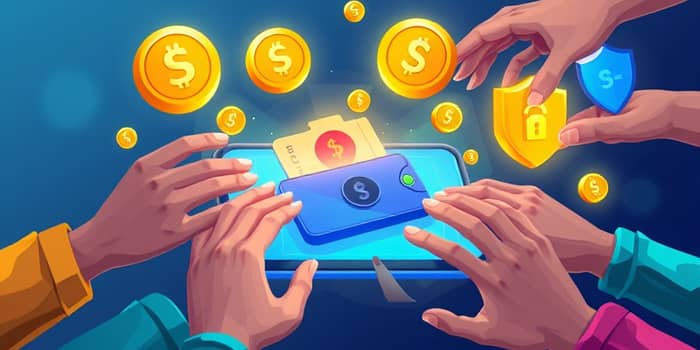In an era where convenience is paramount, digital wallets have become an integral part of everyday transactions. From seamless online checkouts to quick in-store taps, these platforms offer unmatched flexibility and ease of use. This article explores how leading digital wallets combine advanced security with rewarding cashback programs, backed by the latest data and emerging trends.
What Are Digital Wallets?
Digital wallets are software-based tools that store payment information on digital devices, enabling users to conduct transactions without physical cards. Accessible through smartphones, tablets, and computers, they streamline payments by leveraging NFC, QR codes, and online integrations.
Adoption is skyrocketing: recent studies show that over 60% of global smartphone users have installed at least one mobile wallet, and total transaction value topped $7 trillion in 2024. Factors driving this surge include a growing e-commerce market, more contactless-enabled terminals, and a shift in consumer behavior toward cashless lifestyles.
- Mobile wallets (e.g., Apple Pay, Samsung Pay, Google Wallet) for tap-and-pay convenience
- Online wallets (e.g., PayPal, Skrill) for secure e-commerce checkouts
- Prepaid and contactless payment cards that integrate with mobile apps
Emerging variants include blockchain-based wallets and central bank digital currency (CBDC) apps, pointing toward an even more interconnected and tokenized future.
Essential Security Features
Security is the cornerstone of trust in digital wallets. Leading providers implement multiple layers of protection, often exceeding the safeguards found in traditional payment cards.
Encryption is fundamental: most wallets adhere to industry-standard AES-256 and TLS 1.3 protocols, ensuring payments are encrypted at rest and in transit. Tokenization replaces sensitive card details with unique digital tokens for each transaction, making intercepted tokens useless outside their original context. These methods align with PCI DSS requirements and help prevent data breaches.
Biometric authentication adds a robust layer of identity assurance. Vendors commonly deploy fingerprint scans, facial recognition, and even iris scanning in some markets. Combined with multi-factor authentication, wallets demand two or more forms of verification—for instance, a password plus a fingerprint—before granting access or authorizing high-value payments.
Device-level security measures are equally critical. Secure elements, Trusted Execution Environments (TEE), and hardware-backed enclaves isolate cryptographic keys from other system components, safeguarding against malware attacks. Meanwhile, real-time fraud systems monitor for suspicious activity, flagging anomalies such as out-of-pattern purchases or logins from unusual locations. Remote disabling functions let users instantly lock or wipe their wallet if a device is lost or stolen.
Regular third-party audits and certifications—such as ISO/IEC 27001 and SOC 2—help maintain compliance and reassure users. Despite these layers, risks like phishing, SIM swap attacks, and unsecured public Wi-Fi persist, underscoring the need for ongoing improvements and user vigilance.
Cashback and Rewards Explained
Cashback incentives have emerged as a potent tool to attract and retain users. By returning a percentage of purchase value, digital wallets offer tangible benefits that grow with usage.
Typical cashback rates range from 1% to 5%, although special promotions can spike rewards to 10% or more for select categories like dining, groceries, or ride-sharing. For example, in late 2023, Google Pay ran a campaign offering 5% cashback on grocery purchases at partner stores, driving a 20% increase in weekly transactions.
Unlike traditional credit cards, which may have annual fees or tiered interest rates, digital wallets often present fee-free cashback programs. Users can earn rewards directly into their wallet balance, convert points to miles, or deposit cashbacks into bank accounts. Some platforms even allow stack cashback rewards with retailer loyalty programs, effectively doubling the value of each transaction.
Integrations with third-party loyalty schemes, such as airline miles or hotel points, further enrich user benefits. Cross-promotional partnerships create ecosystems where spending in one app yields rewards in another, fostering loyalty and driving higher engagement rates.
Comparing Top Digital Wallets
The table below provides a snapshot of how the leading digital wallets compare in terms of security features and reward structures. Data reflects offerings as of mid-2024—always verify current promotions before deciding.
Additional competitors include region-specific solutions like Alipay, WeChat Pay, and M-Pesa, which dominate in Asia and Africa with localized features and regulatory environments.
Regulation, Liability, & Insurance
Regulatory oversight of digital wallets varies by jurisdiction. In the EU, PSD2 mandates strong customer authentication and open banking interoperability. In the U.S., money transmitter laws and state-level regulations apply, with the Consumer Financial Protection Bureau monitoring compliance.
Liability for unauthorized transactions can be complex. Many wallets offer zero-liability policies up to a specified threshold, aligning with credit card protections. Others classify themselves as “pass-through” payment services, where liability may shift to issuing banks. Always review fraud liability clauses in user agreements to understand your rights and responsibilities.
Funds held in some wallets may qualify for FDIC or FSCS protection if stored in interest-bearing accounts, but balances in purely digital formats often lack direct insurance. Identity verification levels—ranging from basic email confirmation to in-depth KYC checks—determine coverage. Users should confirm insurance status when maintaining significant balances in a wallet.
Consumer Tips & Best Practices
- Choose wallets with established track records for security and regular third-party audits
- Enable biometric login, PIN protection, and two-factor authentication
- Limit app permissions and disable features you don’t use
- Set transaction alerts and daily spending limits to monitor activity
- Use VPNs or secure connections when making online payments
- Immediately lock or erase your wallet if your device is lost
- Compare reward programs periodically to ensure you’re maximizing benefits
Market Trends and Future Outlook
The digital wallet market is on pace to exceed $15 trillion in transactions by 2025, driven by younger demographics who favor mobile payments over cash. Emerging markets in Southeast Asia and Latin America are displaying the fastest growth rates, often leapfrogging traditional banking infrastructure.
Future security enhancements may include continuous behavioral biometrics, where AI models analyze typing patterns or gesture dynamics to confirm user identity. Blockchain-based identity frameworks could decentralize authentication, giving users control over their data. Meanwhile, rewards programs will likely evolve with real-time dynamic pricing and personalized offers powered by machine learning.
The integration of central bank digital currencies (CBDCs) into consumer wallets could further blur the lines between public and private digital money, creating new opportunities for programmable money, smart contracts, and automated settlements. As wallets become hubs for finance, identity, and loyalty, users stand to gain increasingly holistic and secure solutions.
By understanding the interplay between robust security measures and compelling cashback incentives, consumers can make informed decisions about which digital wallets best align with their financial habits and protection needs. Embracing these technologies wisely offers both peace of mind and tangible rewards in our rapidly digitizing world.
References
- https://www.citizensbank.com/learning/is-digital-wallet-safe.aspx
- https://www.algoanalytiq.com/post/digital-wallets-a-convenient-alternative-to-cash-comparing-different-digital-wallet-solutions-and
- https://mobilewallet.cards/mobile-wallet-features-comparison/
- https://advocacy.consumerreports.org/research/raising-the-bar-on-digital-wallets-how-six-leading-platforms-stack-up-on-safety-privacy-and-financial-well-being/
- https://brilliancesecuritymagazine.com/cybersecurity/how-secure-are-digital-wallets/
- https://toucanus.com/blogs/digital-wallet-security-features-to-protect-money/
- https://geniusee.com/single-blog/top-digital-wallets-you-need-to-know
- https://gr4vy.com/posts/will-digital-wallets-replace-credit-cards-an-updated-guide/










